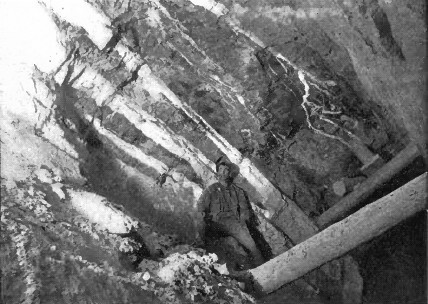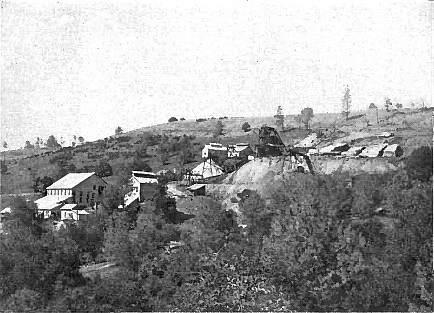The avalanche of gold miners had among its advertisements the Agency of Geo. L. Curry for selling feet in New York, and the local conditions are suggested by the declaration of an editorial that. There should be fewer ledges and more New Yorks. The participation of New York (and of some other capital centers) in quartz development in Montana is shown in charters granted by the first legislature. Among these we may mention The Montana Gold and Silver Mining Company, whose office was in New York; The Rocky Mountain Gold and Silver Mining Company, whose stockholders lived in Bannack, St. Louis, and New York; and The American Gold and Silver Mining Company, whose stockholders were in London, New York, Philadelphia, St. Louis and in Montana.20 Concerning British Columbia a thoughtful observer wrote, Labor has hitherto chiefly performed what has been done, but the performance has been limited, slow and imperfect. Capital must finally develop the resources of the country. Its aid is essential to their full development, but to attract capital it must have free scope, and a reasonable amount of legal protection and encouragement, or, in other words, as much protection as will encourage its introduction. The shaping of laws to encourage capital is mentioned, also, in the first message of Governor Lyon, of Idaho: All legislation should be carefully molded to invite capital, and the greater the inducement held out, the more rapidly will our population be increased and the greater the peoples' prosperity. This, then, was the situation: development in these mining communities by means of the labor of individuals, who had little capital and organization, soon reached its limit; society stretched forth to the centers of capitalism for aid and was willing so to modify its legislation as to favor the introduction of capital.
This movement towards capitalism and corporate methods was tremendously accelerated by the development of the Comstock Lode in Nevada. "The chief gold mines of California," wrote Commissioner Browne, "high as their product is, these are small affairs when compared with the vast works of the chief silver companies of Nevada. A strip of land six hundred yards wide and three miles long yields gold and silver in the amount of $12,000,000 annually. There is no parallel to that in ancient or modern times. With this magnificent yield came decisive resort to corporate methods. Nothing more strikingly illustrates the difference between the miners of California and those of Western Utah, said the Maryville, (California) Appeal, "than the frequent formation in the latter of incorporated companies with a great amount of capital stock. This development in Nevada promptly affected California. In an editorial on The System of Extensive Mining Corporations in Washoe, the Bulletin said : "The clear tendency of things throughout the entire mining region of California is to this end [i. e., combination]. Those who are the possessors of quartz or 'hydraulic claims' must call in the aid of capital and science, if they hope to make their possessions profitable.
These great achievements in Washoe aroused the capitalists of San Francisco who up to 1860 had been quite indifferent to mining investments to active participation in the process of combination. This participation, however, was not altogether healthful, for "it was reserved for Washoe to transfer the most active operations from the fields of actual labor to the pavement and shops of Montgomery Street. After the capitalists became involved, there followed a period of riotous speculation. Two hundred and ten companies were formed in 1861 and 1862, with capital stock of $230.000,000. Men and women of all degrees made haste to invest their savings in mining stock of companies, most of whose holdings were worthless. In 1864 came a great panic in these stocks and the "name of Washoe, which had once been blessed, was now accursed by the multitude, though still a source of profit to the fewer number. The mines of the northern interior, however, were not greatly affected by this excess of speculation or its reaction, except that development was somewhat retarded by the latter. This tendency towards employment of capital in combinations which was discernible in these remote mining communities which we are studying, was apparent in Australia also and, indeed, in all Anglo-Saxon mining localities. Moreover, the period of the Civil War was marked in the eastern United States by the combining of capital and the forming of corporations on a scale before unachieved. The development of mining methods in the camps of the Inland Empire, therefore, in their progression from the simple and hasty methods of the placer miner to the complicated and stable processes of the capitalist and the scientist, shared in the evolution going on in Washoe, California, Australia, and the whole United States.
In considering the Advance of Mining with the labor and capital expended Upon that effort, one naturally inquires what was the total amount of gold produced. Many factors must be taken into account and many sources drawn upon, in order to arrive at an approach to accuracy in estimating the product of the mining regions which we are studying. The opening up of new treasure fields was looked to with very great interest at the time, because their product was regarded as aiding the credit of the nation, helping to restore a specie basis, and, possibly, as directly contributing to the payment of the national debt. The production of gold and silver in the United States, said the Banker's Magazine, "is one of the important financial and social questions of the day. We look to California and other states of the Pacific to yield, for some years to come, an abundant supply of these metals, with which to restore the country to a specie basis in its commerce with other portions of the world. There is little question a man's financial chances were better in the mining regions. When common labor in the East was paid $1 to $1.25 per day in depreciated greenbacks, $5 to $10 a day in gold and the chance of making much more loomed large. There was at this period great labor discontent in the East due to the high prices of commodities, paid in paper currency, such prices unaccompanied by proportionate increase of wages." Even in California a skilled miner could make not more than $3.50 to $4 per day. In mining communities it is evident that the product must necessarily be practically all surplus, and a surplus, moreover, in such form as to be readily transmutable into the various commodities and activities of civilized life. Gold dust circulated as money. Each merchant had his scales and every miner carried his pouch, from the contents of which he bought his food, clothing, tools, newspaper, and drink; paid his postage, express charges and fares; attended the theatre or the hurdy-gurdy, perchance gambled, remunerated his lawyer in litigation, paid his taxes, or bestowed his contributions at church. Civilization sprang forth full-panoplied. Merchants came rushing in ; buildings were erected and towns sprang up; newspapers were established; lawyers, dentists, and doctors hung out their signs; churches and schools were projected and in many cases erected ; transportation thrilled from the pack trail, the stagecoach, the steamboat, through the railroads of the east and the ocean routes of the west, clear to New York and London.
Men at a distance (particularly if unacquainted with mining localities) overlooked the high prices and discomforts of mining .camps a fact peculiarly true of the general run of immigrants from England. After all, moreover, the average annual earnings may not have been as high as they seemed. Dawson computes that the average annual earnings of miners in British Columbia (1858-68) was slightly under $700, but his computation does not take account of the exchange of product for labor in the mines.11 But mainly it was the chance at the great prizes, the chance to make a fortune in a few months, that drew men feverishly on. There were many cases where men within a year or two cleared from $2,000 to $100,000, and, when we reflect on how such sums now are regarded by the average laboring or professional man, we can see what it meant to the ordinary man in the sixties. To the poor man the mines held out the hope of a competency.
If we inquire, however, what were the total net profits in the production of the surplus above discussed, after the deduction of money brought into the country, which is a question impossible to answer. The charge was often made, with regard to any particular mining community (a charge oftenest made by some older community which was losing population) that there really was no net profit, or a positive loss. We may observe, however, that even if this were true, the stimulus to business and the impulse to various forms of social activity were not therefore the less intense, although, perhaps, accompanied with loss to many individuals. Moreover, besides investments in mining improvements directly, as ditches, mills etc., much both of the money brought into a country and of the surplus produced was invested in various permanent forms of capital, such as the opening up of farms, the building up of towns and communities, and the capitalization of trade and transportation. One of the most important permanent improvements, attributable largely to the precious metal product, was the development of agriculture. Prices for all sorts of provisions were very high in the mines, and at the towns and stations on the way thither, and this was particularly true with regard to butter, milk, fresh vegetables, etc. after a man had lived for weeks on bacon, bread and coffee, he would give almost any price for the tonic of butter and vegetables. The economic inducement of high prices was needed in order to settle remote valleys, which, but for the mines, would have waited long for settlers.
Continue on to:
Historic Options For Gold Milling Machinery, Part 1
Return To:
Hard Rock Quartz Mining and Milling


